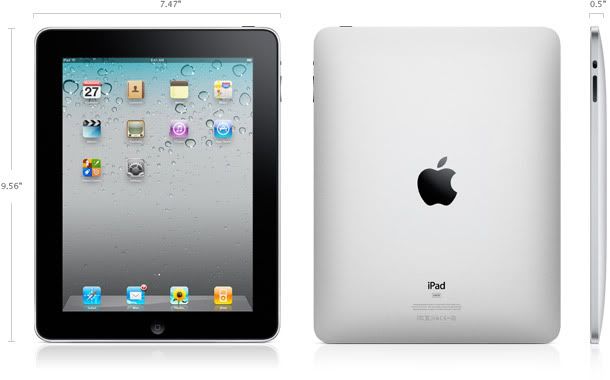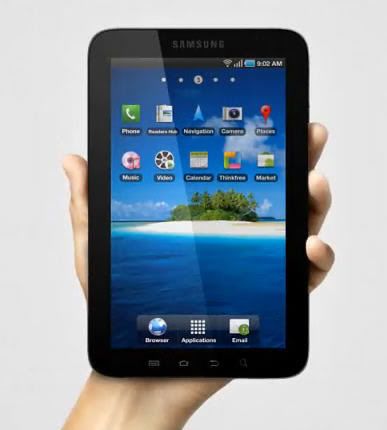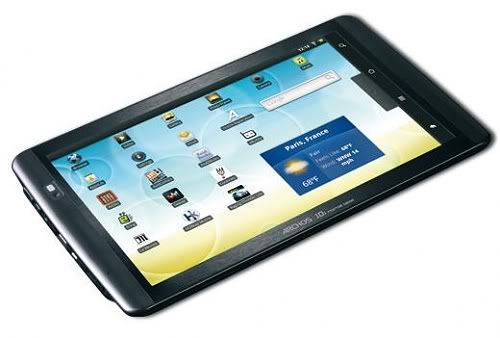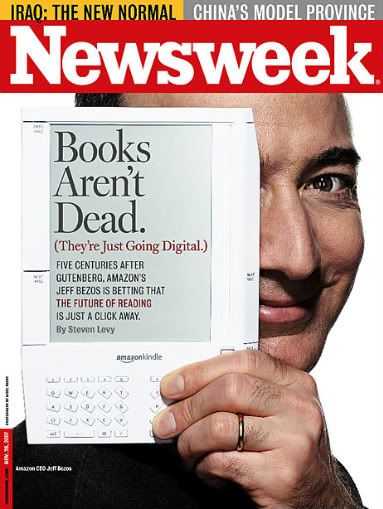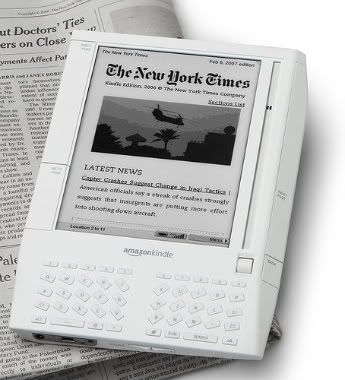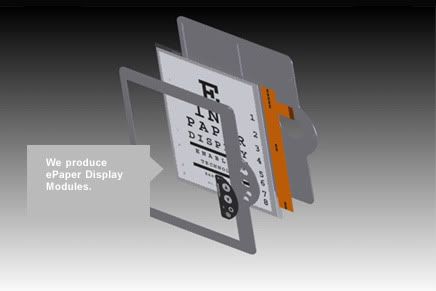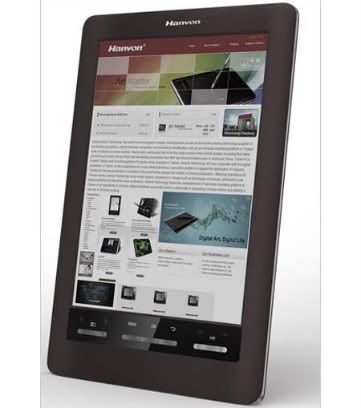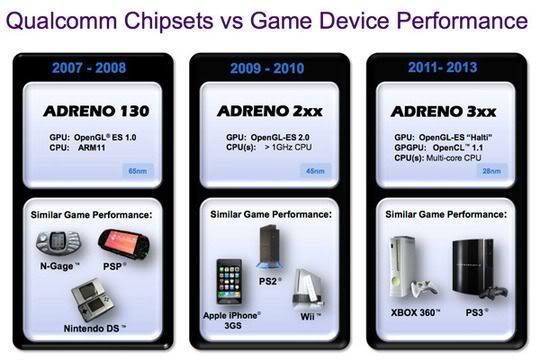Click here to read the first part
Part Two : Tablets
The second approach to e-books was more conventional. Tablets are simply personal computers with often normal LCDs in a, well... tablet form. In the past there have been similar attempts from companies like Intel and Archos to introduce the so-called MIDs (mobile internet devices), but they have failed to effectively penetrate the market. MIDs are larger than smartphones yet smaller than UMPCs (Ultra Mobile PCs), which in turn are smaller than netbooks, so it was never made clear who exactly were the target buyers of these devices.
Here comes Apple and their iPad :
Source : Apple
The iPad still sells like hot cakes, many months after its introduction. Although it
is essentially a larger iPhone 4, and its screen has much lower pixel density (it has roughly the same resolution while measuring 10.1 vs 3.5 diag. inches), it succeeded where the others failed. Why? I guess because it is touted as... supercool. Most of iPad or iPhone buyers do not even look at the speccs, which are quite limited actually. They want them real bad simply because they are a cool and fashionable gadget and they can brag about them to their friends or in their work. But I could analyse the Apple fan-boy psychology in a separate article, let's get back to e-books.
Tablets were naturally not designed or intended exclusively for e-media. It's just that their format makes them suitable for this use as well. But suitable would possibly be an exaggeration. The iPad has a shiny glossy screen that makes it virtually impossible to read under moderately strong ambient light (id est it is sunlight incompatible). e-book exlusive devices have matte screens for exactly that reason.
Furthermore, e-books like Kindle are much closer to the natural feel of paper books.
Most tablets have IPS LCDs but they are still LCDs, with all of the drawbacks I mentioned before. But like I said the iPad sells insanely, and very few of those who buy it would likely intend it primarily for reading e-media. So, much like what has happened with smartphones, the market has already started to be inundated with Android based tablets from competitors who also want a piece of the tablet pie. Let's have a quick look at a couple of them.
This is iPad's main competitor right now, the Galaxy Tab from Samsung :
Source
It runs Android 2.2 and is smaller than the iPad, with a 7" screen. As a result it is also lighter and more portable, fitting in most bags. So it is closer to a pocket book page than a full book, and if the e-media has small fonts you will have to zoom in to read without killing what's left of your eyes; but as we all know that forces us to constantly scroll the page left and right.
Unfortunately it also has a glossy screen.
The other one comes from an old timer in the field :
Source
This very sexy device is the ARCHOS 101 internet tablet As the name suggests it sports a 10.1" screen and is much more sturdily built than both iPad and Galaxy, since it boasts a metal chassis.
Its screen counts 1024 x 600 pixels and unfortunately, you guessed it, it is glossy too.
It costs quite less than iPad or Galaxy, has roughly the same screen speccs and will
not break apart if you drop it from a reasonable height.
Amazon CEO Jeff Bezos
Conclusion.
e-media of all possible forms will eventually replace physical media like books, magazines and newspapers. They may not totally replace them -I still can't see how it could be done with comics for instance- at first but they will stop being the dominant form, as Mr. Negroponte predicted. Costs of printed media will continue to rise and this will be a decisive factor for the transition to e-media. Eventually all major and middle-weight publishers will switch to e-formats. Printed media will likely be produced in minimal volumes to address the wants and needs of some old-fashioned individuals "who love touching, feeling and even smelling paper"*, including myself.
e-books and tablets still cost a lot because it is a niche technology and their R&D has not yet been depreciated. Soon the prices of these devices will drop dramatically and their flaws will be fixed. This will most likely lead to a large scale adoption. And then, I suppose that we should guard our existing books much like we guard our own eyes, because their collectible value and price will rise considerably.
*many thanks to Kiriko and her owner for this line!
© 2010 Nikolaos D. Skordilis
sources:
Daniweb and some of the links cited above
Delicious bits and bytes on current technological news and scientific advances, that the Techworm feasts on and then presents at this cosy little corner of his.
Showing posts with label Amazon. Show all posts
Showing posts with label Amazon. Show all posts
Thursday, 9 December 2010
Tuesday, 7 December 2010
Will e-books swallow printed media?
Part One : e-books
It is more likely not a matter of if but when that happens.
Nicholas Negroponte, the co-founder of MIT's Media Lab, recently claimed that "the physical book will be dead in five years."
Not dead as a goner already inside the coffin, but rather dead as not the dominant form, id est zombie dead. But still, five years? That's too soon isn't it? Well, predictions for even the next year are always rather shaky and Mr Negroponte has wrongly predicted not a few things before.
Source
Yet his point is valid. Physical books, magazines and newspapers appear to be the last analog castle, everything else has gone digital (cinemas and the film industry are somewhere in the middle of the transition but it is coming). They are already relentlessly besieged by e-books like Kindle, Nook and Sony Reader, tablets and whatever else can connect to the Web and downoad or just view on-line a book, article, newspaper etc. It might eventually take ten to fifteen years but paper in general will clearly become obsolete, unfortunately for physical book lovers and fortunately for trees.
In this article I will present the current trends and different technologies and products in this highly competing field, along with the usual comments, views and may even dare a couple of estimations.
LCDs are not particularly comfortable to read on. They strain your eyes, they are too bright, have relatively low contrast, consume too much power and they are virtually unreadable under sunlight. E-Ink, a company based in Taiwan but with ties in Korea, mainland China and the States, recognised this need and developed a new kind of display technology, the E Ink format. This was not based on liquid crystals but on "pigments made of millions of tiny microcapcules" (check out here if you are hungry for more of this):
Source : E-Ink
This technology is what made your Kindle, Nook and Sony Reader possible.
The greatest drawback of the E Ink format was that it used to be unable to display colours, but even that has been now fixed with the latest development from E-Ink, the E-Ink Triton colour ink display. This is the first product from Hanvon sporting this tech, already available for pre-order :
Source : E-Ink
Currently the main competitors among E-Ink based e-book makers are Amazon with Kindle, Barnes and Noble with Nook and Sony with its Reader. There are also a few other smaller asian companies craving for a piece of this aggressively growing market.
Black & white e-books are still quite pricey but their prices drop fast.
Naturally colour ones are expected to be more expensive when they roll out.
continued in Part Two : Tablets
© 2010 Nikolaos D. Skordilis
It is more likely not a matter of if but when that happens.
Nicholas Negroponte, the co-founder of MIT's Media Lab, recently claimed that "the physical book will be dead in five years."
Not dead as a goner already inside the coffin, but rather dead as not the dominant form, id est zombie dead. But still, five years? That's too soon isn't it? Well, predictions for even the next year are always rather shaky and Mr Negroponte has wrongly predicted not a few things before.
Source
Yet his point is valid. Physical books, magazines and newspapers appear to be the last analog castle, everything else has gone digital (cinemas and the film industry are somewhere in the middle of the transition but it is coming). They are already relentlessly besieged by e-books like Kindle, Nook and Sony Reader, tablets and whatever else can connect to the Web and downoad or just view on-line a book, article, newspaper etc. It might eventually take ten to fifteen years but paper in general will clearly become obsolete, unfortunately for physical book lovers and fortunately for trees.
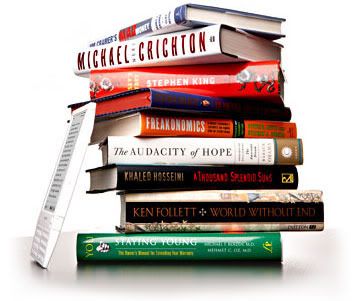 |
In this article I will present the current trends and different technologies and products in this highly competing field, along with the usual comments, views and may even dare a couple of estimations.
LCDs are not particularly comfortable to read on. They strain your eyes, they are too bright, have relatively low contrast, consume too much power and they are virtually unreadable under sunlight. E-Ink, a company based in Taiwan but with ties in Korea, mainland China and the States, recognised this need and developed a new kind of display technology, the E Ink format. This was not based on liquid crystals but on "pigments made of millions of tiny microcapcules" (check out here if you are hungry for more of this):
Source : E-Ink
This technology is what made your Kindle, Nook and Sony Reader possible.
The greatest drawback of the E Ink format was that it used to be unable to display colours, but even that has been now fixed with the latest development from E-Ink, the E-Ink Triton colour ink display. This is the first product from Hanvon sporting this tech, already available for pre-order :
Source : E-Ink
Currently the main competitors among E-Ink based e-book makers are Amazon with Kindle, Barnes and Noble with Nook and Sony with its Reader. There are also a few other smaller asian companies craving for a piece of this aggressively growing market.
Black & white e-books are still quite pricey but their prices drop fast.
Naturally colour ones are expected to be more expensive when they roll out.
continued in Part Two : Tablets
© 2010 Nikolaos D. Skordilis
Ετικέτες
Amazon,
E Ink,
E Ink Triton,
Hanvon,
Kindle,
Media Lab,
MIT,
Negroponte,
Nook,
Sony Reader
Saturday, 4 December 2010
Qualcomm promises mobile PS3 - XBOX360 performance soon
Next generation Snapdragon Adreno 3xx series is expected by Qualcomm to boast current high end console performance.
According to Anandtech, next generation ARM Snapdragon SoCs (Systems on a Chip), the same chips that form the "heart" of your iPod, iPad or Android smartphone , are expected to boast a x5 boost in overall performance, which would bring them on par with your PS3 or Xbox360. These chips will be multicore (2+ cores), of a 28nm architecture, and much more power efficient than current 45nm/65nm ones.
Adreno 3xx generation is scheduled for the 2011-2013 timeframe.
This rendering by Qualcomm demonstrates concisely all three Adreno generations and their relative performance to various popular devices:
Picture source
These predictions, if fulfilled, would make current Atom chipsets, even the ones paired with ION, to pale in comparison. There is no clear date as to when exactly Qualcomm will start delivering the chips, nor any talk about frequencies yet. My guess is 2011 Q2. These chipsets are set to be implemented in everything up to netbooks, though their primary target devices will be high-end smartphones and tablets, for example the 2nd gen iPad.
Image via CrunchBase
It will be fascinating to have all this horsepower in your pocket, yet much of it would go wasted without the appropriate operating system and some killer applications to run on top of it. So what is now to be expected from the OS engineers, programmers and developers, is to optimise the next version of Android, iOS and Meego with some new fine code that fully takes advantage of this family of chips.
© 2010 Nikolaos D. Skordilis
I originally published this article on Gameolosophy
According to Anandtech, next generation ARM Snapdragon SoCs (Systems on a Chip), the same chips that form the "heart" of your iPod, iPad or Android smartphone , are expected to boast a x5 boost in overall performance, which would bring them on par with your PS3 or Xbox360. These chips will be multicore (2+ cores), of a 28nm architecture, and much more power efficient than current 45nm/65nm ones.
Adreno 3xx generation is scheduled for the 2011-2013 timeframe.
This rendering by Qualcomm demonstrates concisely all three Adreno generations and their relative performance to various popular devices:
Picture source
These predictions, if fulfilled, would make current Atom chipsets, even the ones paired with ION, to pale in comparison. There is no clear date as to when exactly Qualcomm will start delivering the chips, nor any talk about frequencies yet. My guess is 2011 Q2. These chipsets are set to be implemented in everything up to netbooks, though their primary target devices will be high-end smartphones and tablets, for example the 2nd gen iPad.
Image via CrunchBase
It will be fascinating to have all this horsepower in your pocket, yet much of it would go wasted without the appropriate operating system and some killer applications to run on top of it. So what is now to be expected from the OS engineers, programmers and developers, is to optimise the next version of Android, iOS and Meego with some new fine code that fully takes advantage of this family of chips.
© 2010 Nikolaos D. Skordilis
I originally published this article on Gameolosophy
Subscribe to:
Posts (Atom)
